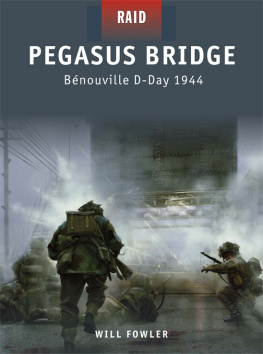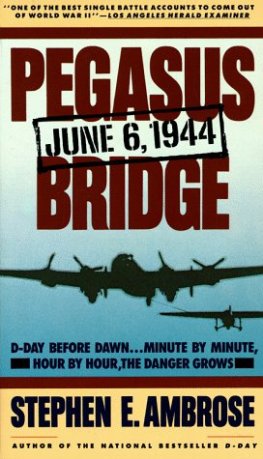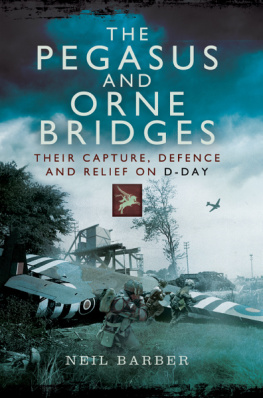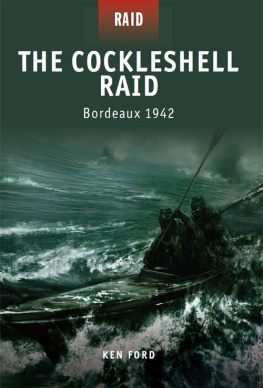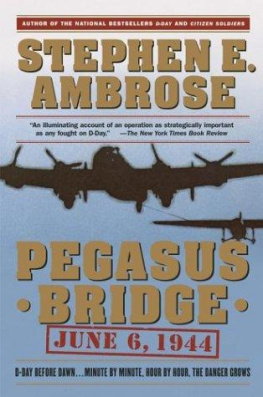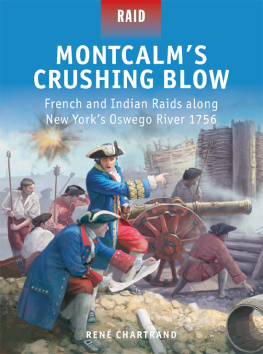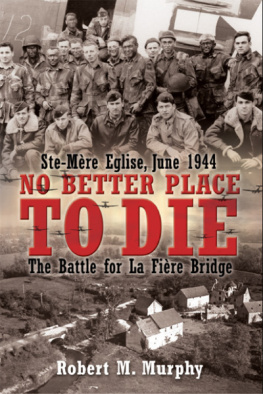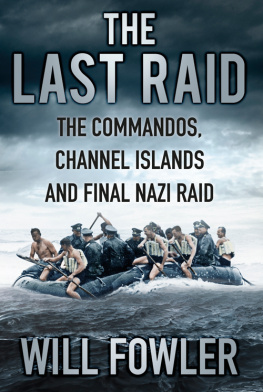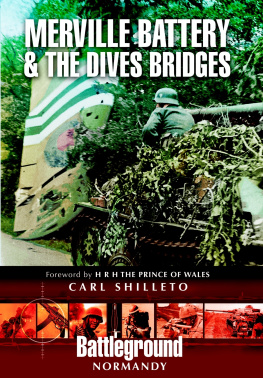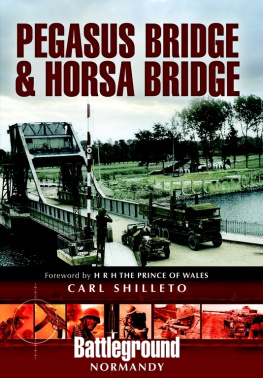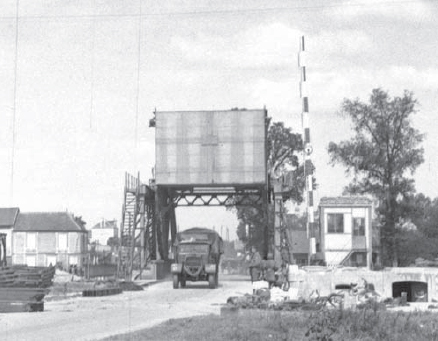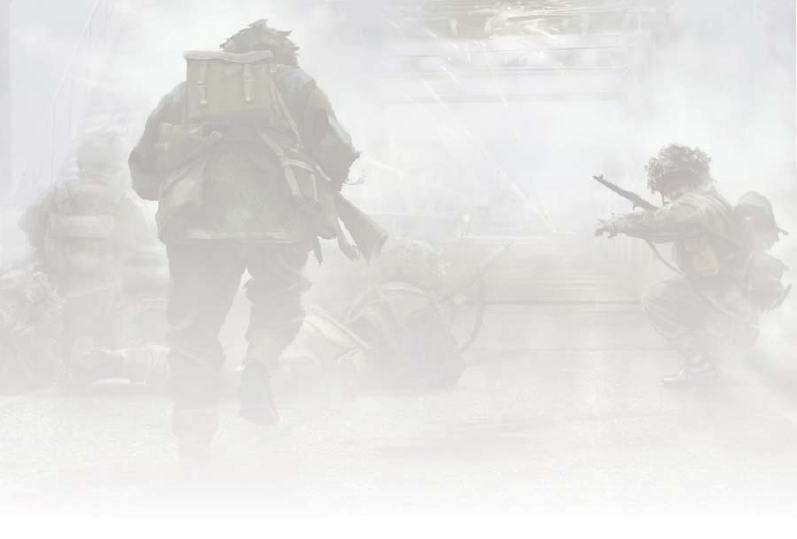PEGASUS BRIDGE
Bnouville D-Day 1944
WILL FOWLER
CONTENTS
INTRODUCTION
To the young German soldier and his comrade, standing guard on the bridge across the shipping canal at Bnouville in Normandy early on the morning of 6 June 1944, it seemed as if a flak-damaged Allied bomber had crashed on the far bank. An aircraft of some type had certainly come hurtling down from the cloudy night sky and ploughed across the ground towards the eastern end of the bridge.
What 18-year-old Pte Helmut Romer, an easy-going big city boy from Berlin, did not realize was that he had become the first German soldier to witness D-Day, the Allied invasion of Normandy. The crashing aircraft was in fact the first of three troop-carrying gliders, and the bridge he was guarding was the objective of a company of highly trained and superbly led British soldiers of the Oxfordshire and Buckinghamshire Light Infantry. Moments after the landing, these soldiers had charged out of the gliders, stormed across the bridge, suppressed the defences and captured this key D-Day objective, all in about ten minutes.
In the 21st century, the Realities of War training programme, devised for junior soldiers at the British Army Foundation College (AFC) at Harrogate, takes young men and women to the battlefields of Normandy. It is an opportunity for these 16- and 17-year-olds to see the places where in the summer of 1944, men, some only a little older than themselves, fought against a tough, well-equipped and battle-hardened enemy. Among the sites they visit are this bridge at Bnouville and another bridge about half a mile away across the River Orne. Today these are known respectively as Pegasus Bridge and Horsa Bridge, and the author is one of several Royal British Legion guides who have had the privilege of taking the young soldiers from AFC Harrogate to this unique battleground.
The soldiers who assaulted and captured the bridges in the early hours of the morning of D-Day, the Allied landings in Normandy on 6 June 1944, had been delivered to their objective by Horsa gliders. Today the officers and NCO staff from Harrogate, many of them veterans of operational tours in Iraq and Afghanistan, compare the Horsa gliders to the Chinook helicopter, the workhorse troop transport in these theatres. What distinguishes yesterdays Horsas from todays Chinooks is that once the glider pilots had started the descent flight to the landing zone (LZ) in 1944, there was no going back: pilots, glider and troops on board were committed to action it was a one-way ride to death or glory. They were also making this hazardous landing without any of the sophisticated night vision aids available to pilots today to land a Horsa at night, the pilots had only the Mark 1 Eyeball.

The Caf Gondre, the first house to be liberated on D-Day and the Company Clearing Station in the fighting that followed, and now run by Arlette Gondre, the daughter of the original owners. She continues a tradition of hospitality for British soldiers, both serving and veterans, that was begun at dawn on 6 June 1944. (WF)
To be exact, the glider-borne assault and capture of the two bridges was not a raid but a coup de main, a surprise attack launched to capture and hold a single key target. A raid would, for example, have seen troops capture and demolish the bridges and then withdraw. Here the tiny force captured and held the bridges until they were relieved by paratroops.
Soon after the capture of the bridges, ACM Sir Trafford Leigh-Mallory said of the incredibly accurate landing by the glider pilots that it was probably the finest feat of flying in World War II a true compliment, coming from a very senior and often very critical RAF officer to young NCO glider pilots, all of whom were soldiers.
ORIGINS
The landings at Pegasus Bridge grew out of the wider planning for D-Day a process that had begun almost as soon as the British Expeditionary Force (BEF) had been forced out of France in 1940 and evacuated from the beaches of Dunkirk.
The Normandy beaches to the west of the River Orne had been identified as a possible area for a landing. Most of them were areas of flat, open sand on which landing craft could beach safely, and tanks, guns and vehicles could land. The south coast of England had several large ports that would accommodate troops and shipping before the invasion. Finally, the beaches were within range of single-engined fighters operating from airfields on the British mainland.
Aware that the French coast facing England was the most likely site for an invasion, the Germans had begun building coastal defences as far back as 1942. The main weight of defences lay around the ports and along the coast opposite Dover the shortest route across the English Channel, and consequently the most logical area for an invasion force to land.
Both the British and the Americans had seen the success of German airborne forces in the opening years of World War II and were quick to see their potential. Intense selection and training programmes were instituted, and soon both nations had formidable airborne forces. Men could be delivered to battle by parachute (paratroops) or by glider (airborne).
The British adopted the distinctive maroon beret for airborne forces; at one stage the newly formed Special Air Service (SAS) was required to swap its distinctive sand-coloured berets for maroon. While the Parachute Regiment had its own distinctive cap badge of a winged parachute surmounted by a crown, older air-landing formations retained their regimental cap badges, and the Oxfordshire and Buckinghamshire Light Infantrys silver bugle horn badge was backed with a rifle-green patch. On their battledress tunics the men sported the striking Pegasus insignia.
In the summer of 1942 LtGen Boy Browning, appointed as Commander of the 1st Airborne Division, asked the distinguished artist Edward (later Major) Seago to design an emblem for the airborne forces. In October that year Seago produced a classic design, a maroon square upon which was the outline in pale blue of the mythical Greek warrior Bellerophon riding the winged horse Pegasus.
Normally, both parachutes and gliders were used in major operations since gliders could carry heavy weapons and vehicles such as jeeps, anti-tank guns and even the Tetrarch light tank. The attraction of the glider, which the Luftwaffe had demonstrated at the modern Belgian fort of Eben Emael in 1940, was that like todays troop-lift helicopter, it could put down a formed group normally of platoon strength on a compact landing zone. The British required their glider pilots not only to deliver men and equipment safely into battle, but also to join them on the ground to fight as infantry following the landing. Paratroops were less vulnerable but could be scattered by the wind or the speed at which they exited from the aircraft, or both. It could take time for a group of paratroops to form up and become an effective fighting force.
The drawback of gliders was that they were very vulnerable, being made from light materials such as fabric and wood. While some might crash, killing and wounding the occupants, others could be raked with small-arms fire as they approached the landing zone.
Despite this drawback, from as early as 1940 the British had begun development of the Horsa troop- and cargo-carrying glider, to meet War Department specification X.26/40. The first Airspeed Horsa made its maiden flight on 12 September 1941. The specification stated that the gliders were to be built in a number of sections, using facilities not needed for more urgent aircraft production, and as a result manufacture was spread across separate factories, which limited the likely loss from air raids.

